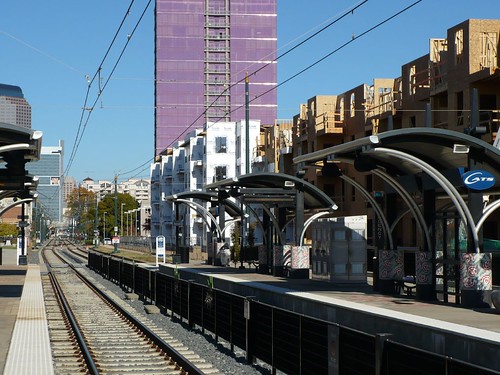An excuse for Kansas City not going back after light rail is the usual complaint. We're not dense enough. Via the Urbanophile from the KC Star:
The city is set up for cars. As a result, most of the metropolitan area is not densely populated...Generally, an average of 6,600 to 10,000 people per square mile is needed to score federal funds. But Kansas City isn’t close to that number along the 14-mile route that voters rejected in November.So now, since they aren't dense enough currently(even in AC's weighted density) and use that as an excuse to not move forward, there will be no change and they'll continue to drift in autodom. But the problem here is not just the lack of imagination and foresight, but also that the current FTA gives no hope of change. People will continue as long as we let them to refer to the cost-effectiveness index as god's law. It's all about the now when in reality we should be planning for the future.
The point of building a rail line today, whether it's light rail, a subway line, or a streetcar is the shape the future development of a corridor but this is something that isn't measured in the current process, at least with any meaning. This is something Congressman Oberstar is looking to fix, but we need to help.
So Charlotte gives us some clues as to what we can look forward to in terms of changing neighborhood dynamics and creating a demand for future density in transit corridors. It also shows that the cost effectiveness index does not determine the success of a project, no matter how much weight seem to put on a single metric based in auto engineering. That doesn't mean we shouldn't look at the costs and weight it against the benefits. It just means the way we're doing it now is weighted towards killing meaningful projects. Places that need subways are forced by cost shock and the CEI to look at light rail and places that should have light rail are forced to BRT and so on down the heirarchy. I hope this changes, and that the "not dense enough" canard can't be used against a city looking to change its ways ever again.At this point, however, the Federal Transit Administration has declared the cost effectiveness index number and not transit oriented development as the critical factor in giving a thumbs up or down to a project. It's time for the CEI not just to be amended, but eliminated, says Rep. Jim Oberstar, chair of the House Transportation and Infrastructure Committee says.
"As soon as there is a Federal Transit Administrator I will encourage that person to, by executive order, erase it from the books. And if they don't we'll do that in legislation."The cost effectiveness index became the deciding factor for transit projects in April, 2005. That's when the FTA received a letter from the Bush administration's Office of Management and Budget proclaiming the CEI's primacy.
Charlotte South Corridor:


5 comments:
Good point about projects that should be heavy rail being downgraded to light rail. I'm not complaining about getting a light rail Purple Line (MD Washington inner suburbs), the corridor is dense enough and has enough already existing TOD to justify heavy rail from a planning perspective.
However, we never went there because we knew that it would be impossible to get it funded at the federal level. Don't get me wrong, we're happy for a light rail Purple Line over nothing.
My apologies to the Mayor of Cleveland - I said it was he was used the density excuse to promote BRT instead of light rail, but it was RTA CEO & General Manger, Joseph A. Calabrese.
I don't know for sure that the Mayor did not use this same excuse, but I have no evidence of it. And I would guess that he had to at least tacitly approve of the BRT-instead-of-LRT move by RTA and Calabrese.
Phoenix is much less dense than Cleveland, and still chose to build LRT.
http://www.toledoblade.com/apps/pbcs.dll/article?AID=/20080812/NEWS16/78160778
As I said in the comments to another post, changing the CEI to a significant extent comes down to Obama.
"The city is set up for cars. As a result, most of the [Kansas City] metropolitan area is not densely populated..."
Gotta love this. This idea that Kansas City "is set up for cars" is only after the road lobby ripped out mile after mile of streetcar tracks, in a bad action, and built lots of highways. And now they're saying they can't support light rail over there because Kansas City is "not dense enough".
But Kansas City isn't the only Midwestern city with such an example. I could talk about all of the places that once extensively operated streetcars - Cleveland, as you (Peter) noted as an example - or other examples like Cincinnati and Milwaukee, and these come to my mind a lot. They had a shifting to government favouritism for more highways.
Post a Comment